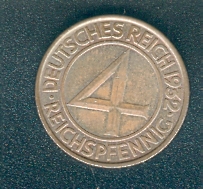Course coin

A currency coin or a circulation coin is a coin that is minted for payment transactions . The course coin is legal tender in the issuing country and is denominated in the respective national currency . Their imprinted value is guaranteed by the respective national bank - even if it is mostly a coin, i.e. the pure metal value is below the face value . In contrast to this, there are virtually no more Kurant coins as currency coins today.
Name origin / word meaning
The term "Kursmünze" is derived from the verb kursieren ("circulate") and is therefore synonymous with the term "Umlaufmünze". In accordance with its intended use, the most important component of a currency coin is, in addition to the nationality, the face value with currency unit ( coin nominal ). The nominal values of a set of coins correspond to the amounts required in the respective country at the time, which may also be unusual under certain circumstances.
In contrast to the commemorative coin , the current coin corresponds to the stamps of the "permanent series" (in contrast to the commemorative, motif and collector's stamps).
Differentiation from other coins
Of the coin differ commemorative coins , minted in the first place for collectors, sample coins , medals and tokens which no monetary character.
However, there are also current coin sets that are sold to collectors in protective packaging with the coin preservation grade “unmarked gloss” (without damage to circulation) and with the mint quality “Polierte Platte” or “Spiegelglanz”.
Historical coins

Most of the historical coins belong to the circulation coins, as only relatively few commemorative coins were minted before the 20th century. The oldest still valid circulation coin in the world is the ten centime piece from Switzerland from 1879, with which payment can still be made today. Currency coins made of base metals from the period before industrialization (around 1870) and silver and gold coins from the period before the Second World War have a certain collector's value, which goes well beyond the material value .
